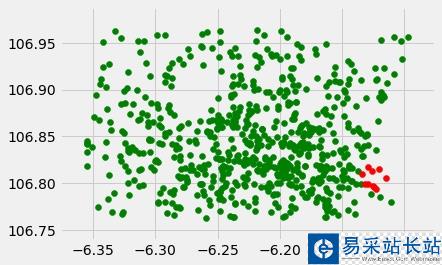numpy中矩阵选取子集或者以条件选取子集,用mask是一种很好的方法
简单来说就是用bool类型的indice矩阵去选择,
mask = np.ones(X.shape[0], dtype=bool)X[mask].shapemask.shapemask[indices[0]] = Falsemask.shapeX[mask].shapeX[~mask].shape(678, 2)(678,)(678,)(675, 2)(3, 2)
例如我们这里用来选取全部点中KNN选取的点以及所有剩余的点
from sklearn.neighbors import NearestNeighborsnbrs = NearestNeighbors(10).fit(X)_,indices = nbrs.kneighbors(X)mask = np.ones(X.shape[0], dtype=bool)mask[indices[0]] = Falseplt.scatter(X[mask][:,0],X[mask][:,1],c='g')plt.scatter(X[~mask][:,0],X[~mask][:,1],c='r')

带条件选择替换,比如我们需要将a矩阵内某条件的行置换为888剩余置换为999,可以直接用mask或者再用where一步搞定:
mask = np.ones(a.shape,dtype=bool) #np.ones_like(a,dtype=bool)mask[indices] = Falsea[~mask] = 999a[mask] = 888#############np.where(mask, 888, 999)
以上就是本文的全部内容,希望对大家的学习有所帮助,也希望大家多多支持武林站长站。
新闻热点
疑难解答